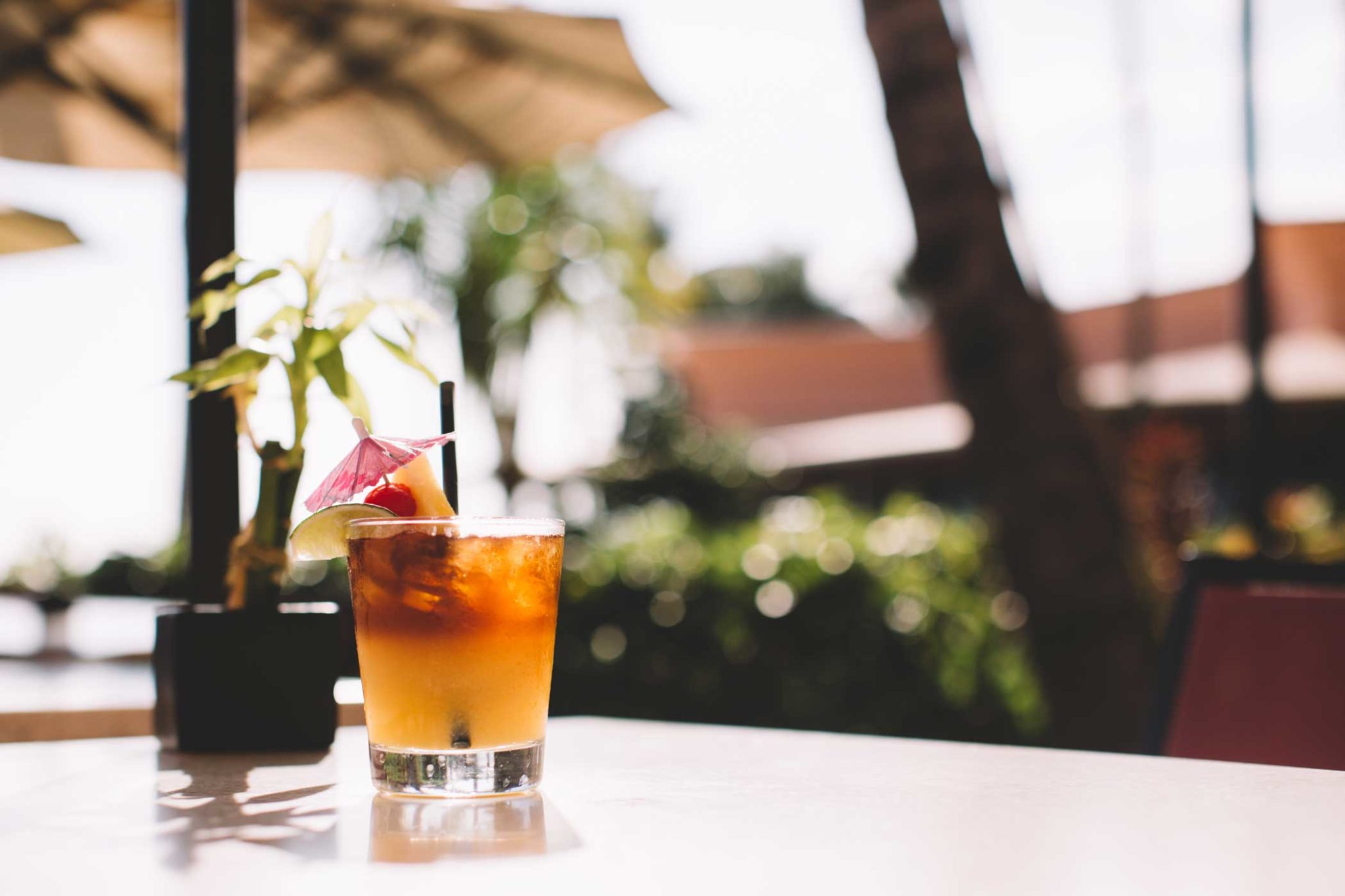Cocktails associated with the Pacific were born of one man’s imagination, and have a lasting legacy in Hawaii.
Text by Martha Cheng
Images by Jonas Maon and John Hook
Tiki drinks may have been inspired by Hawaii and other “exotic” places, but they actually originated in the imagination of one man in Los Angeles: Donn Beach. It was Beach, an erstwhile bootlegger shut out of his restaurants on the U.S. mainland, who brought tiki to Hawaii.
As a young man, Beach traveled the world, including the islands in the Caribbean and South Pacific, and eventually landed on the shores of Hollywood. Born Ernest Raymond Beaumont Gantt, he changed his name to Donn Beach after the success of his restaurants.
Going Legit
During Prohibition, Beach became a bootlegger and ran a speakeasy. When Prohibition ended, he went legit, opening the first Don the Beachcomber restaurant and bar in 1934. Thus, the tiki bar—a fantastic figment of Beach’s imagination—was born. This tiki theme was named after the first man on Earth in Maori mythology, and its kitsch décor often referenced culturally significant wooden sculptures of Polynesian gods.
In Hollywood’s Golden Age, Beach’s bar drew stars like Charlie Chaplin, Orson Welles, and Marlene Dietrich, who reveled in its faux Polynesian decor and rum cocktails—tasty spirits that evoked exotica with names like “Caribbean Punch” and “Hot Tiger’s Milk.”
Back then, rum was cheap, there was plenty of it, and no one wanted to drink it. But Beach knew what to do: He created drinks by blending multiple rums, layering molasses-heavy dark rums with lighter floral ones, and combining them with fruit juices and flavored syrups of his own invention. They were the first drinks of their kind.
Donn Beach created drinks by blending multiple rums, layering molasses-heavy dark rums with lighter floral ones, and combining them with fruit juices and flavored syrups of his own invention. They were the first drinks of their kind.
Growing Empire
When World War II called Beach away (to Europe, where, ever the restaurateur, he ran canteens for the Army), his wife and business partner, Cora Irene Sund, otherwise known as “Sunny,” took over operations of Don the Beachcomber, expanding the empire to 16 locations.
When Beach returned, the couple divorced, with Sund retaining control of the restaurants and the company name in the United States. In a case of imagined exotica looping back to its original source material, Beach brought his tiki restaurant vibes to Waikiki, Hawai‘i pre-statehood, in 1948. He even built a fantasy Polynesian village around the establishment: the International Market Place.
In its heyday, the International Market Place encompassed 50 shops, night clubs, and restaurants, three of which were owned by Beach, including Don the Beachcomber’s Treehouse, built high in a banyan tree and located at the center of the property.
A Legend is Born
The Treehouse was a private place for two, complete with a bed, sarongs (should a couple desire to slip into something more comfortable), and a door that could be locked from the inside. In 1961, legendary surfer and swimmer Duke Kahanamoku opened a restaurant and club at the marketplace, called Duke Kahanamoku’s Supper Club.
Here, Kahanamoku launched Don Ho’s music career while serving drinks like the Duke’s Pearl, a mix of passionfruit juice, honey, lime juice, and light and dark rums, with every fifth drink garnished with a real pearl.
Over at Don the Beachcomber, bartenders whipped up libations like the Vicious Virgin, Missionary’s Downfall, and Cannibal Grog. But the Mai Tai, which became the iconic drink of both tiki and Hawai‘i, was actually invented by Beach’s greatest rival: Victor Bergeron of Trader Vic’s restaurants. Bergeron had started his own restaurants after visiting Beach’s, opening his first establishment in Oakland, California.
Trader Vic’s
In 1941, Bergeron debuted a Trader Vic’s in Honolulu on Ward Avenue, near King Street. Like Don the Beachcomber’s sprawling empire, this bar also morphed into a franchise of 25 restaurants.
Tiki culture grew steadily in the ’50s, as imitators opened their own tiki bars, and soldiers returning from the war looked to relive their memories of Hawai‘i and the South Pacific at these watering holes. The post-war economy—and statehood—fueled travel to Hawai‘i, adding more even fire to the tiki craze.
But by the ’70s, the tiki trend had faded. The original Don the Beachcomber was paved over to make way for a parking lot, and tiki drinks—once complex concoctions made with fresh fruit juices—gave way to syrupy cocktails. In 1989, Beach himself was laid to rest in the National Memorial Cemetery of the Pacific in Honolulu.
Now, decades later, bartenders looking to the past for flavorful inspiration are shaking and stirring tiki culture into the modern craft cocktail movement.
-
You Will Also Like:
Enjoying the Flavorful Life in Honolulu with Valerie Wang
Where to Order Hawai’i’s Best Tiki Cocktails
O‘AHU
Blue Hawai‘i and Tropical Itch at Hilton Hawaiian Village
Harry Yee, who served as Hilton Hawaiian Village’s head bartender for 30 years, created some of the tiki scene’s most iconic drinks. He was also the first to garnish the cocktails with paper umbrellas and Vanda orchids, and the first to stick a backscratcher in a drink of his own invention, aptly named the Tropical Itch. When he was starting out, Yee said tourists would ask for a “Hawaiian drink.” He didn’t have any on the menu, so he invented the Hawaiian Cooler, Guava Lada, Hot Buttered Okolehao, and Diamond Head. The Blue Hawai‘i and Tropical Itch are still served at the hotel’s bars to this day.
Scratch Mai Tai at The Royal Hawaiian Mai Tai Bar
The Mai Tai’s origin story is set in 1944, when Victor Bergeron mixed together aged rum, fresh lime juice, orange Curacao, rock candy syrup, and orgeat (almond syrup) at his original Trader Vic’s restaurant. He served it to friends, who as the tale goes, exclaimed, in Tahitian, “Maita‘i roa ae,” or “Out of this world!” And into this world came tiki’s iconic drink, forever to be copied, modified, and bastardized.
Bergeron himself tweaked the drink in 1953, when the Royal Hawaiian Hotel commissioned him to create drinks for its menu. It was there that he added pineapple juice to the Mai Tai. The Royal Hawaiian still serves this cocktail, now called the Scratch Mai Tai, a fruitier and sweeter concoction that swaps out the lime for pineapple and orange juice, but otherwise keeps much the same ingredients as Trader Vic’s very first Mai Tai.
Mai Tai at House without a Key
Mai Tai purists gather at the House Without a Key, where the cocktail hews closely to the original recipe. This version is strong, with two rums in its base and a float of dark rum, but swirls of rock candy and orgeat syrups work to smooth any rough edges, as do the sunset views.
La Mariana Sailing Club
As the tiki trend faded, parts of disassembled bars found their ways to La Mariana Sailing Club: carved tikis from the Sheraton’s Kon Tiki Room, koa wood tables from Don the Beachcomber, fishing floats from Trader Vic’s. Here, the drinks are strong and deviate from the original recipes (the Zombie is nothing like Donn Beach’s invention), but soak in the atmosphere and the alcohol, and all will be ok.
All in the Reflexes at The Pig and the Lady
Named for a line in Big Trouble in Little China, this cocktail, shown being made on the previous page, brings southeast Asian flavors into the mix. Ko Hana agricole rum, distilled in Kunia with locally grown sugarcane, is shaken with egg white, lime, basil, coconut milk, and crème de banane infused with Thai chilis, resulting in a frothy, fizzy, yet creamy drink that packs just enough heat to make your tongue tingle.
MAUI
Lokelani Swizzle at Ka‘ana Kitchen
New York mixologist Julie Reiner created the cocktail menu at Ka‘ana Kitchen, and it’s filled with refreshing and balanced tropical drinks, such as the Lokelani Swizzle, shown above, featuring layers of delicate flavors including white rum, rosehip, hibiscus tea, lime juice, and liliko‘i.
Rollin’ Down the Street at Monkeypod Kitchen Wailea
At Monkeypod Kitchen, the Rollin’ Down the Street cocktail boasts a gin base, as opposed to tiki’s traditional rum roots. But the drink tastes as tropical as those concoctions from the 1940s, if not more so, thanks to the addition of housemade macadamia nut orgeat syrup, pineapple juice, lemon, and macadamia nuts.




